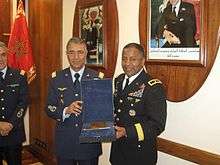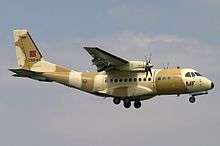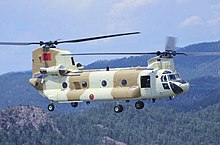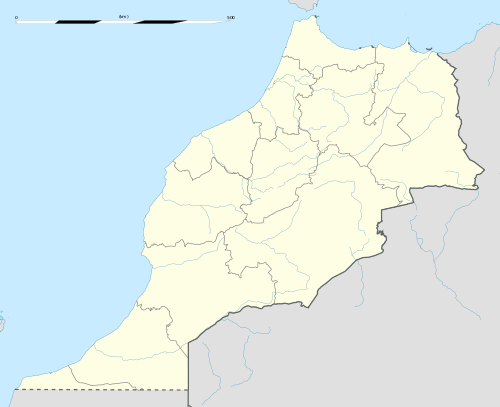Royal Moroccan Air Force
The Royal Moroccan Air Force, RMAF, (Arabic: القوات الجوية الملكية; Berber: Adwas ujenna ageldan; French: Forces royales air) is the air force branch of the Moroccan Armed Forces.
| Royal Moroccan Air Force | |
|---|---|
 Royal Moroccan Air Force emblem | |
| Founded | 1956 |
| Country | Morocco |
| Type | Air force |
| Role | Aerial warfare |
| Size | 13,500 personnel |
| Part of | Administration of Defense |
| Equipment | 397 aircraft |
| Engagements | Sand War Six-Day War Yom Kippur War Western Sahara War International military intervention against ISIL Saudi Arabian-led intervention in Yemen |
| Commanders | |
| Military Leadership | General El Abed Alaoui Bouhamid |
| Supreme Commander | Mohammed VI |
| Insignia | |
| Roundel |  |
| Fin flash |  |
| Aircraft flown | |
| Attack | Alpha Jet |
| Electronic warfare | Dassault Falcon 20 |
| Fighter | F-16 Fighting Falcon, Northrop F-5, Mirage F1 |
| Attack helicopter | SA 342 AH-64E Apache[1] |
| Multirole helicopter | CH-47, SA 330, AB205 |
| Reconnaissance | RC-130H SLAR, R4E-50, Predator XP, I-GNAT ER, Heron |
| Trainer | B300, T-6C, A-Jet E+, F-5F |
| Transport | C-130H, CN235M, C-27J |
| Tanker | KC-130 |
History
The Moroccan air force was formed on November 19, 1956 as the “Aviation Royale Chérifienne” (Sherifian Royal Aviation).
Its modern installations and bases were inherited from France (Meknes, Rabat {in tandem with the United States}, Marrakech), the United States (Rabat {in tandem with France}, Kenitra, Benguérir, Boulhault, Nouasser and Sidi Slimane) and Spain (Laayoune).
The first acquisitions of this newly formed air force were six Morane-Saulnier MS-500 Criquets, three Max Holste MH.1521 Broussard transport aircraft, two Beechcraft Twin Bonanzas, a de Havilland DH.114 Heron and a Bell 47G helicopter.
In 1961, it changed its name to "Force royales air" (Royal Air Force), a designation used to the present day. In the same period, it obtained 12 Mikoyan-Gurevich MiG-17 fighters, two Mikoyan-Gurevich MiG-15UTI trainers and four Ilyushin Il-28 bombers from the Soviet Union (USSR). 24 Fouga Magister training aircraft were also received from France.
The political rift with the USSR pushed Morocco to seek a new ally in the United States, acquiring from the latter six Northrop F-5 combat aircraft (4 single-seat F-5A and 2 two-seat F-5B) and another 20 F-5A and four F-5B in 1966. Transport aircraft acquired at the time included 10 Douglas C-47 Skytrains, 18 Fairchild C-119Gs and six Lockheed C-130 Hercules. The helicopter fleet was composed of 24 Agusta-Bell AB205As, and 12 North American T-6 Texans were used for pilot training.
The next modernization of the Moroccan Air Force took place just before the Sahara conflict, with the acquisition of Mirage F-1CH attack aircraft, Beech T-34C Mentor training aircraft, Aerospatiale Puma helicopters, and new Hercules transport aircraft to substitute the older units. Modernization of Northrop F-5 Freedom Fighter with improved technology and the purchase of 24 Alpha Jet E would later be undertaken by the RMAF; another modernization of the fleet of Dassault Mirage F1 was achieved in 1996 and 1997.
During the 90s there were plans for purchasing Mirage 2000 or F-16 fighter aircraft, however due to unavailable funding they were not realized. By 2011 the Royal Moroccan Air Force started to modernize its ageing fleet by buying F-16s.[2]
Operations
Sand War
The RMAF participated in the Moroccan-Algerian border conflict in 1963 known as Sand War.
Yom Kippur War
During the Yom Kippur War a Squadron of Moroccan Air Force Northrop F-5A joined the Egyptian 69 Squadron at Tanta on 19 October 1973. At least 14 MiG-17s and also around a dozen of F-5As were deployed. The F-5As arrived after a lengthy trip, via Tunis and Libya, accompanied by Lockheed C-130 Hercules transports that carried spare parts, weapons, and equipment. Moroccans started flying tasked with CAP missions over the Nile Delta. In January 1974 two F-5As armed with AIM-9B and 20mm cannons, intercepted a pair of IAF Mirage IIICs on a reconnaissance mission. As the Israelis turned away once the F-5As became evident, dragging both RMAFs fighters behind them, concerned about a possible ambush by IAFs F-4E Phantom IIs the EAF mission control ordered both Moroccan Fighters to return, replacing them by two EAF MiG-21MFs.[3]
Western Sahara War
At the beginning of the Western Sahara War conflict, Fouga Magister (based at Laayoune) and North American T-6 Texan (based at Ad Dhakla) were initially in ground support mission and night attacks. Later on, the F-5 aircraft were thrown into action, to strike against POLISARIO targets. From the beginning, the objective of Morocco was to create a controlled and safe zone in the area considered as “useful” for its political and economic interests, that is, the Capital Al-Aaiun, the religious center Smara, and the phosphate field of Bu-Craa.
In 1980 construction of the Sahara defensive walls began, consisting of every type of obstacle for infantry and armoured vehicles, such as mines and radars, all backed by Quick Intervention Units (Détachements d'Intervention Rapide) able to move to and quickly reinforce every location along the wall, aided by air-transport composed of Super Puma, AB-205 and CH-47 Chinook helicopters. As to the anti-tank defenses, it was decided additionally to use Aérospatiale SA 342 Gazelle helicopters with HOT missiles to neutralize the POLISARIO T-54, T-55 and BMP tanks. And apart from the ground radars of the Wall, two C-130 Hercules with SLAR system were also used for the detection of enemy units.
After the loss of 1 F-5A and 2 RF-5A in the battles, 20 F-5E "Tiger II" and 4 F-5F were acquired. The main problem that faced the F-5 in Western Sahara was its insufficient range to realize missions in depth in the vast battlefield of the Sahara desert. To minimize this problem, a B.707-138B fitted with Beech hose units at the wingtips for refueling and 2 Lockheed KC-130H were also delivered beginning 1982 to provide the Moroccan “Tiger II” with air-to-air refueling, and consequently increase their attack range.
The Mirage F-1 were responsible for defending the air-space against a possible Algerian or Libyan attack, whose governments supported both financially and politically the Polisario Front, during the beginning of the conflict.
In 1977, the Moroccan Mirage pilots started their training in an Air-force base located in Orange, France. In this same year, the Moroccan Air Force started receiving its first Mirage F-1C fighters. Libya and Algeria did not attack Morocco, and consequently Morocco destined its Mirages to ground-attack missions against POLISARIO. 3 Mirage Deliveries were received between 1978 and 1982. The first delivery were 30 Mirage F1-CH received between February and December 1978. The second one, was received between December 1979 and July 1982 and comprised 14 Mirage F1-EH. Between July 1980 and June a final delivery of 6 Mirage F-1EH-200 was received.
With the losses of Fouga Magister, the FARM decided to buy a total of 24 Rockwell OV-10A from the United States Marine Corps. The first 6 aircraft were delivered, but with the early loss of one of them, the rest were transferred to a maritime patrol role due to their inefficiency in combat. The program was cancelled for the rest of the aircraft.
Intervention against ISIL
In late 2014 Morocco sent F-16s into combat against ISIL in Iraq and Syria.[4][5] This was the first deployment for the jets since Morocco purchased them in 2011.[6][2]
Modernization in the 21st century

[7] The Royal Moroccan Air Force started a progressive modernization program of its ageing fleet and their technical and operational capacities. In 2007, Morocco formally requested 24 T-6C Texan trainer aircraft, with very secondary light attack capability, and 24 F-16C/D Block 52+ aircraft as well as associated equipment and services, with:
- F100-PW-229 Enhanced Engine Package (EEP) turbofan engines
- AN/APG-68V9 radars
- conformal fuel tanks (CFTs).
Later, from 2008 to 2012 the RMAF purchased advanced equipment for its F-16 fleet:
- Advanced countermeasures electronic systems (ACES).
- Joint Helmet Mounted Cueing Systems (JHMCS).
- AN/AVS-9 night vision goggles.
- AN/APX-113 Advanced Identification Friend or Foe (AIFF) Systems.
- AN/ALQ-187 Advanced Self-Protection Integrated Suites (ASPIS II).
- AN/ALR-93 radar warning receivers.
- DB-110 airborne reconnaissance pods.
- AN/AAQ-33 Sniper Advanced Targeting Pods (ATPs).
.jpg)
Advanced armament was also acquired:
- AIM-120 C7 Advanced Medium Range Air-to Air Missiles (AMRAAM).
- AIM-9M-9 and AIM-9X Block II Sidewinder short range air-to-air missiles.
- AGM-88B/C HARM Missiles.
- AGM-65D/G/H MAVERICK Missiles.
- AGM-158 JASSM Missiles.
- AGM-84L Harpoon Block II Missiles.
- GPS/INS and Laser-guided Joint Direct Attack Munition (JDAM) tail kits.
- GBU-24 Paveway III, GBU-10 Paveway II and GBU-12 Paveway II laser-guidance and fin kits to convert 2,000 pound bombs.
The RMAF also started the MF2000 Dassault Mirage F1 upgrade program, which has upgraded 27 Mirage F1s (F1CH, F1EH and F1EH-200) to the level of Mirage 2000-5 to improve survivability for the MF2000, that included :
- The replacement of the old Thomson-CSF Cyrano IV radar by Thales RC400 (RDY-3).
- 4% thrust boost and longer life through a new compressor module for the Snecma Atar 9K50 engines.
- New cockpit Layout with Two LCD multifunction, a Head-Up Display with UFCP (Up Front Control Panel), two LCD multifunction, Two mini-LCD (to RWR and artificial horizon) and full HOTAS controls.
- Inertial-aided GPS Navigator Sagem Sigma 95.
- CN2H-AA Mk II Night-Vision Goggles.
- Modern Zero-zero ejection seat.
- New electronics:
- New weapons management system.
- Advanced Thales Radar-warning system.
- New Data Link.
- Improved communications-system.
- Two Dynamic task computer-integrated with a 1553 bus.
The upgrade enabled the use of more advanced equipment as:
- Corail flare launchers.
- Phimat chaff dispensers.
- Electronic protection-Pod PAJ-FA ECM.
- Thales Damocles Pod.
- Capability to carry Advanced Air-to-air missiles, Air-to-ground missiles and guided-bombs :
- Matra R550 Magic-II & MICA IR/EM Air-to-air missiles.
- Armement Air-Sol Modulaire (AASM) GPS/INS and GPS/INS+IIR guided bombs.
- AM39 Exocet Air-to-sea missiles.
- Paveway Laser-guided bombs.
[8] Before all those upgrades, Improvements to F-5A/B were realised with the installation of "Tiger II" avionics on, probably, 8 F-5A and 2 F-5B. A contract was stipulated with the French company Sogerma at Bordeaux (France), all aircraft were received by 1998. [9] From 2001 to 2004 the RMAF's F-5E/F received a full refurbishment and upgrade from SOGERMA and Lahav (IAI). The upgraded improved the performance of the "Tiger II" to the level of the "Tiger III". The work carried up included:
- new FIAR Grifo F/X Plus improved radar (similar in performance to the AN/APG-69)
- Elettronica ELT/555 active Electronic Countermeasures (ECM) pods.
- HOTAS (Hands On Throttle And Stick)
- New EWPS/-100 (DM/A-104) RWR
- Cockpit Layout with new:
- heads-up display
- Weapons Delivery and Navigation System MFD/WDNS
- Multifunction displays
The F-5E/F TIII acquired the capability to use new weapon systems such as Beyond Visual Range missiles and precise-guided weapons. RADA ACE ground debriefing station,[10] a Simulator and AN/AAQ-28(V) LITENING targeting pods have also been purchased.
%2C_Morocco_-_Air_Force_AN0832501.jpg)
In 2008, 4 C-27J Spartan tactical transport aircraft were also purchased from Finmeccanica subsidiary Alenia Aeronautica, and the advanced trainer and CAS/COIN aircraft Alpha Jet E fleet was upgraded to the "E+ standard". One year later, 3 CH-47D were requested, to be added to the 9 CH-47C delivered in 1979 and 1982 (originally 12 were acquired). General Atomics received in 2010 export licenses to sell an unarmed export version of the Predator to Saudi Arabia, Egypt, U.A.E. and Morocco. Six aerial firefighting Bombardier 415 Superscooper were also purchased in 2011. The modernization and upgrade of the former US Air Force base in Ben Guerir Air Base to support its F-16 Fighting Falcon aircraft is also important. In March 2013, it has been confirmed that the RMAF have purchased from France at least 3 MALE UAVs IAI Heron.[11]
In 2019, Government of Morocco requested purchase of 25 F-16 blok 72 and was approved by The U.S. Department of State.[12] First shipment of 12 new Vipers will be received in 2021. [13]
The existing F-16's will also be upgraded to the block 72 Viper standard.[14]
Accidents
In July 2011, a RMAF C-130H crash killed 78 people after the aircraft, en route from Dakhla, a city in Morocco to Kenitra Air Base in Kenitra, crashed 9.7 km (6 mi) from a planned stop-over at Guelmim Air Base.
The 6 crew, 60 members of the army and 12 civilians, mainly partners travelling with their partners, perished in the accident.
In November 2012, nine soldiers were killed and two seriously injured in a SA330 Puma crash in the same region of Guelmim during combined forces exercise.[15]
On May 11, 2015, a Royal Moroccan Air Force F-16 which was taking part in air campaign in Yemen crashed due to technical faults.[16]
On 16 August 2015, a Mirage F1 was lost after a bird strike.[17]
On 21 January 2019, a Mirage F1 has crashed in Taounat area due to technical problem. The pilot has ejected before the crash.[18]
Ranks
- Officers
| Equivalent NATO code | OF-10 | OF-9 | OF-8 | OF-7 | OF-6 | OF-5 | OF-4 | OF-3 | OF-2 | OF-1 | OF(D) and student officer | |||||||||||||||||||||||||
|---|---|---|---|---|---|---|---|---|---|---|---|---|---|---|---|---|---|---|---|---|---|---|---|---|---|---|---|---|---|---|---|---|---|---|---|---|
(Edit) |
No equivalent |  |
 |
 |
 |
 |
 |
 |
 |
 |
 |
 |
No equivalent | |||||||||||||||||||||||
| Général d'armée Aerienne | Général de corps Aerienne | Général de division Aerienne | Général de brigade Aerienne | Colonel Major | Colonel | Lieutenant-Colonel | Commandant | Capitaine | Lieutenant | Sous-Lieutenant | ||||||||||||||||||||||||||
- Général de l'armé et commandant en chef: Retained by His Majesty the King of Morocco.
- Enlisted
| Equivalent NATO Code | OR-9 | OR-8 | OR-7 | OR-6 | OR-5 | OR-4 | OR-3 | OR-2 | OR-1 | |||||||||||||||||||||||||||
|---|---|---|---|---|---|---|---|---|---|---|---|---|---|---|---|---|---|---|---|---|---|---|---|---|---|---|---|---|---|---|---|---|---|---|---|---|
(Edit) |
 |
 |
 |
 |
 |
 |
No insignia | |||||||||||||||||||||||||||||
| Warrant Officer Class 1 Adjudant-chef |
Warrant Officer Class 2 Adjudant |
Sergeant Major Sergent-major |
Staff Sergeant Sergent-chef |
Sergeant Sergent |
Corporal Caporal-chef |
Lance Corporal Caporal |
Private First Class Soldat Première |
Private Soldat | ||||||||||||||||||||||||||||
Airbases
- Salé BAFRA Nº 7 (Air Base)
- Meknes BAFRA Nº 6 (Air Base)
- Kenitra BAFRA Nº 5 (Air Base)
- Laayoun BAFRA Nº 4 (Air Base)
- Sidi Slimane BAFRA Nº 2 (Air Base)
- Ben Guerir BAFRA N°1 (Air Base)
- Oujda BAFRA N°0 (Air Bases Headquarter)
- Marrakech BEFRA (Academy Air Base & Air Base)
- Rabat North Area Headquarters
- Agadir South Area Headquarters
- Casablanca Aeronaval Base
- Khouribga Annexe AeroBase
Aircraft
Current inventory


References
- Judson, Jen (November 20, 2019). "US State Dept. approves $4.25 billion Apache helo sale to Morocco". Defense News.
- http://www.defensenews.com/article/20110804/DEFSECT01/108040305/Morocco-Takes-Delivery-F-16-Jets
- "Moroccan F-16 Carry Out Airstrikes Against ISIS". 10 December 2014. Archived from the original on 23 December 2014. Retrieved 23 December 2014.
- FARS. "Morocco Sends its F16s to Syria and Iraq to Fight ISIS". The Moroccan Times. Archived from the original on 2014-12-23. Retrieved 2014-12-23.
- Schmitt, Eric (26 November 2014). "U.S. Adds Planes to Bolster Drive to Wipe Out ISIS". New York Times. Archived from the original on 16 May 2017. Retrieved 3 March 2017.
- "Moroccos Air Force Reloads: And Now, The Training". Archived from the original on 2012-10-19. Retrieved 2012-11-20.
- "Archived copy". Archived from the original on 2013-07-19. Retrieved 2012-11-29.CS1 maint: archived copy as title (link)
- http://i61.servimg.com/u/f61/09/01/13/73/sdc10715.jpg
- "f13.jpg - Click to see more photos". ImageShack. Archived from the original on 2013-12-15. Retrieved 2013-04-28.
- "Morocco – F-16 Block 72 New Purchase | The Official Home of the Defense Security Cooperation Agency". www.dsca.mil. Retrieved 2020-05-21.
- Guessous, Hamza (2018-10-30). "Morocco to Receive F-16 Fighting Falcon Planes in 2021". Morocco World News. Retrieved 2020-05-21.
- "Morocco – F-16 Block 52+ Upgrade to F-16V Configuration | The Official Home of the Defense Security Cooperation Agency". www.dsca.mil. Retrieved 2020-05-21.
- "Archived copy". Archived from the original on 2012-11-16. Retrieved 2012-11-16.CS1 maint: archived copy as title (link)
- "Moroccan F-16 crashes over Yemen". www.f-16.net. Archived from the original on 2016-02-24. Retrieved 2016-02-08.
- "Un avion Mirage F1 monomoteur des Forces Royales Air s'est écrasé lundi au sud de la Base aérienne de Sidi Slimane (communiqué)". lemag.ma. Archived from the original on 2015-08-20. Retrieved 2015-08-20.
- "Archived copy". Archived from the original on 2019-01-22. Retrieved 2019-01-22.CS1 maint: archived copy as title (link)
- "Arabian Aerospace - Mirage upgrade augments new fighter force". www.arabianaerospace.aero. Retrieved 2020-05-21.
- "World Air Forces 2020" (PDF). Flightglobal Insight. 2020. Retrieved 16 January 2020.
- "Morocco maintains army modernization plan | The North Africa Post". northafricapost.com. Retrieved 2020-06-10.
- "World Air Forces 2004 pg. 75". Flightglobal Insight. 2004. Retrieved 28 September 2015.
- "Morocco receives CH-47D". AirForces Monthly. Key Publishing. October 2015. p. 22.
- "Morocco maintains army modernization plan | The North Africa Post". northafricapost.com. Retrieved 2020-06-10.
- "Morocco plane crash claims 80 lives". Archived from the original on 26 July 2011. Retrieved 27 July 2011.
External links
- Order of Battle at Scramble.nl
- Moroccan air force fleet photos - airliners.net
- Moroccan air force losses - skywar.ru
